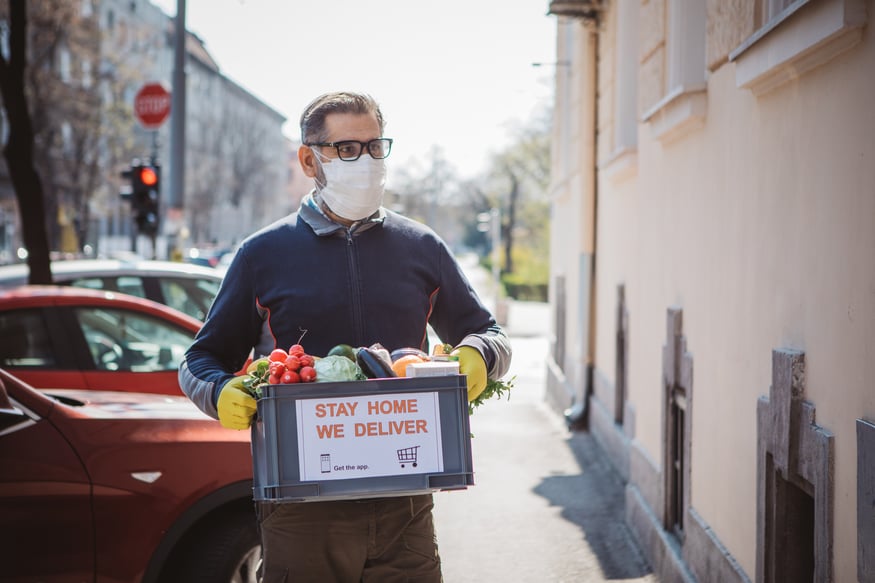Bond
Has Grocery Shopping Changed Forever?
As consumers, our grocery shopping behaviors and experiences have been drastically altered as a result of COVID-19. Grocers have had to make unprecedented changes to the shopping experience in order to safeguard their employees and customers. Unsurprisingly, it is expected that many of these changes will continue to persist and that new ones will form in a post COVID-19 era. Many believe that the grocery experience that we know and have come to take for granted, will be forever changed, as a result of the pandemic.
In order to understand which behaviors and experiences will stick and what else we can expect to change in a post COVID-19 world, it is important to first examine how consumers have been impacted during the pandemic, and what new realities have dramatically changed the current grocery shopping journey.
CHANGES AT RETAIL
Need for personal precautions: New preparations such as masks, gloves, and hand sanitizer are now par for the course when it comes to physical shopping, both for employees, and for consumers.

Significant Inconveniences: Physical in-store barriers such as lane directions, single checkout lines, social distancing barriers, and other new rules have made the in-store experience cumbersome and far less enjoyable than before.
Restricted shopping hours: Stores have reduced operating hours to better balance their employees’ availability/workload and to allow for the restocking of empty shelves.
Radically slower process: The above-mentioned changes to the physical store experience mean that lining up to enter the store, navigating one-way aisles, waiting to check out—all take more time than ever. A big planned trip, such as a monthly grocery trip, which might have taken an hour in the past, can now take two or three times that long.
Supply chain stockouts: The panicked hoarding of toilet rolls now seems like a distant memory, but we are still seeing key products with supply issues causing additional customer frustration. In fact, in our recent survey on the effects of COVID-19 on shopping habits, we found that for 87% of people*, it is important that products are readily available at their closest location, showing that this is still an issue that is top of mind for the majority of consumers.
E-commerce delays: E-commerce volumes have grown exponentially out of fear of entering a physical retail format, and therefore timely fulfillment by grocers has been a challenge.
IMPACT ON CONSUMER SENTIMENT AND BEHAVIORS
More in-depth planning rituals: As consumers try to minimize the time they spend in any communal space, the need for more preparation and organization has come to the fore. COVID-19 means shoppers are no longer able to easily and readily go to the store for unexpected filler grocery trips on a whim. Moreover, people are anxious to ensure all of their shopping is done quickly and in one trip, and shopping lists have become even more vital to increase efficiency and speed once in the store.
Health anxieties and fears: Fear of infection while shopping has led to an increase in stress, during what was previously an enjoyable experience for many shoppers.
Lack of socialization during shopping: Stores have become increasingly quiet and no longer act as a social hub for communities, since there is no longer the comfort of socializing with staff or fellow shoppers.
Shopping for many: As consumers are focused on protecting their loved ones and those who are older or at risk, many are now shopping for multiple parties in once visit. Shopping cart and payment splitting at the point of sale have all led to a prolonged and more onerous grocery shopping experience.
Price desensitization: Product scarcity and time constraints have led many consumers to be less price-sensitive on essential products of which they are in dire need to purchase. Similarly, and unfortunately, in some rare instances, we have been witness to price gouging by some grocery retailers.
WHAT WILL STICK?
So, what will the future of grocery look like in a post COVID-19 world? What is certain is that it will not be the same as before. It is fair to say that the grocery experience as we know it will be forever changed, just like several other industries will be. Here are some of our predictions:
Continued exponential growth in e-commerce: Customers who have been transacting in this channel will likely continue to do so. However, a new cohort of customers (including seniors) who have not used e-commerce in the past, have tried it during COVID-19, have experienced the merits of the channel, and will now adopt it as a preferred shopping method going forward.
New store-entry restrictions: While store hours will eventually return to regular hours of operation, grocers will maintain many of the health and safety protocols introduced during COVID-19. We're already seeing important new measures being undertaken in areas that are reopening, such as mandatory face masks for staff and customers, and temperature checks to qualify/disqualify entry to the store. Rigorous sanitation procedures imposed during the pandemic will also need to be kept in place and be transparent to customers. These new health and safety protocols will be imperative in maintaining a safe environment as well as garnering consumer confidence.
Tender shift and contactless payments: Cash is no longer king—in our survey, 67% of consumers* stressed the importance of contactless payment options. We have been trained out of using physical currency, and a large portion of those who moved from cash to credit or debit will continue to use electronic tender types. More than ever, consumers are using mobile apps to safely and quickly scan and pay. These habits will stick and grow at grocery post-COVID-19. It remains to be seen if issuers will maintain the recently increased tap thresholds permitted for convenience and safety. This will result in a reduction of costs associate with cash handling for grocers and greater POS throughput efficiency.
Reduced frequency of shopping: We found during COVID-19 that customers visited grocery stores less but purchased more per trip. It is expected that this memory reflex will persist, and that consumers will be trained to be more efficient when grocery shopping. While filler grocery trips will return to some extent, we expect to see less of them. For grocers it will mean that their efforts will be even more focused on getting that big planned grocery trip share of wallet.
Pantry loading and forward buying: Post-COVID-19, we might not see the same radical pantry loading; however, consumers of all cohorts will be more inclined to think about keeping a sufficient supply of staples on hand in the event of another wave of a pandemic. This will result in a greater degree of forward buying on key essentials such as canned and ingredient foods, paper products, over-the-counter medications, and sanitation products.
Shift from prepared foods to preparing food: Cooking and baking have definitely been the standout new hobby that most people have gravitated towards during the pandemic. We have seen a shift away from “prepared foods” to buying ingredients to “prepare foods”, like bread making, baking, cooking, etc. For some, these new habits and hobbies will continue to persist among a portion of grocery consumers.

New brand preferences, including Private Label: As the grocery shelves of popular grocery items sat empty during COVID-19, consumers’ brand loyalty eroded. Substitutions made due to necessity will naturally lead to new brand preferences and buying post-COVID-19. This will be most pronounced for private-label products. We have seen a significant spike in private-label sales penetration during the pandemic, and expect that this memory flex will persist and as a result will negatively impact national brand sales penetration in several grocery categories.
New selling channels for groceries: Consumers have increasingly supplemented their grocery spend through other channels, and these habits are likely to endure. These new grocery channels include food meal kit subscription companies, wholesale food distributors now selling directly to consumers, and fast casual restaurants offering groceries. We have even seen the introduction of new grocery formats such as “grocers on wheels,” who will bring a grocery truck to your driveway and let you select your items from their well-stocked mobile shelves. These new channels have become convenient for traditional grocery shoppers and can only increase in popularity. They have attracted a whole new cohort of consumers. Grocers can expect further channel blurring and competition from these and other emerging food supply channels.
LOYALTY IS KEY
With all this disruption and change during COVID-19, customer retention is more important than ever. We have already seen grocers pivot their loyalty programs in order to help support their customer’s shopping experience in the following ways:
Rewards Value: Many grocers have made it easier, faster, and more economically valuable to redeem program points for free products in their selling channels.
Shareability: Some grocers have made it easier for Members to pool their program points to extract more value from the program.
New Program Benefits: Some operators have introduced new assets into their program that were previously unavailable (e.g., new redemption options, partnerships, services such as meal subscriptions, etc.).
Flexibility and Leniency: Several loyalty programs have relaxed program terms and conditions to permit Members to use the program in ways that were previously unavailable or prohibited.
Fee Waivers: Several grocers have permitted Members to leverage convenience services, like free delivery and free bags, during this time of need.

New Conveniences: New benefits that make the shopping experience more convenient have been introduced, e.g., app checkout, in-app grocery lists, auto-replenishment, etc.
Community Support: Several grocers have introduced new ways in which Members can help front-line workers and disadvantaged members of their communities through the program.
POST-PANDEMIC LOYALTY
45% of consumers* believe that catering to loyal customers is important, even during this crisis when many people's loyalties have shifted. We expect this number to only grow as we settle into our new normal. And as we proceed towards a post-pandemic era, we believe that grocery loyalty programs will be poised to play an increasingly significant, integrated, and different role in the grocery customer's experience. While monetary benefits will continue to be an important element of the loyalty value proposition, these programs will pivot to play more of the emotional and social responsibility loyalty role in Members' lives.
Value Focus: We can expect continued economic hardship for and a focus on survival and perseverance by a large portion of the population, so loyalty programs will need to focus more on providing immediate and tangible monetary value.
Access: Tiers within programs might provide Members with new access to features and benefits that make it easier, more convenient, to shop with grocers. There will be less of a focus on luxury and more of a focus on what is practical and makes the Member’s experience better—for instance, shopping by appointment to avoid wait times at store entry.
Data and Personalization: More than ever, leveraging data to understand new attitudinal customers’ behaviors and addressing their unique needs will be central to brands’ future success. We know that the pandemic has generated new purchasing behaviors and product preferences, and new ways in which products are being used. It will be important for brands and grocers to be considerate of these new habits and to serve up offers, experiences, and content that meet these new preferences and behaviors and keep Members loyal.
New Partnerships: Expect new partnerships to emerge to create better branded experiences focused around health and safety, convenience, trust, and consolidation of everyday shopping needs.
Pay-2-Play: There will be a greater uptake in fee-based and subscription services, and a willingness to pay for such services. The pandemic created isolation and a whole new population of consumers who have warmed up to subscription models across multiple sectors. These subscription-based services will reduce the need for shopping trips and as much interaction with physical stores, and will act as a new revenue base for grocers. Bold operators may even choose to guarantee supply for in-demand, limited-quantity items.
Drive to Bond: Isolation does not need to be isolating. During the pandemic, loyalty programs have found new ways to bring like-minded Members together digitally to socialize with others and keep connected emotionally to the brand. We expect to see these mechanics embodied to a greater extent into grocery programs post-COVID-19.
Drive to Create: In response to the crisis, loyalty programs have found ways to foster self-betterment and greater good for communities at large. These mechanics have been greeted with enthusiasm by Members and will continue to be a focus in in loyalty offerings post-COVID-19.
In summary, the grocery sector will be changed forever due to the experience and behaviors exhibited by consumers, and the actions taken by grocers during the pandemic. Consumers’ shopping attitudes and priorities have changed, and many will become more habitual in this new normal. That said, loyalty programs will be able to resume their important role of treating their best customers best, and making their Members’ experience with the brand better.
*Source: Bond COVID-19 State of Consumer Loyalty Pulse Survey. Wave 4: May 8th (n=1,511)